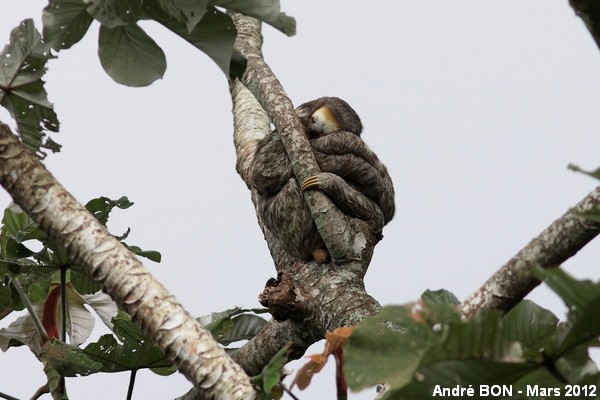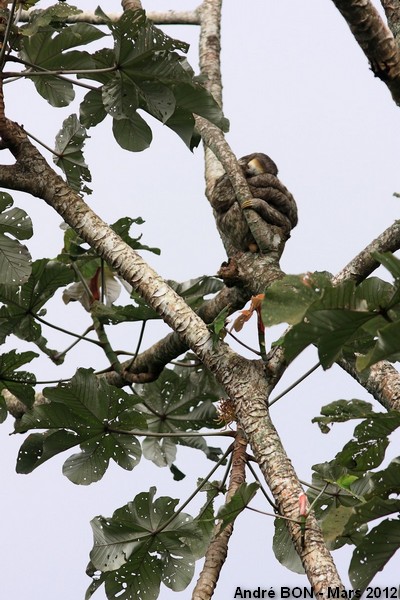

| Pale-throated Sloth (Bradypus tridactylus (Linnaeus, 1758)) |


|
|
Scientific name: Bradypus tridactylus (Linnaeus, 1758) Common name: Pale-throated Sloth French name: Paresseux à trois doigts, Paresseux à gorge claire, Mouton paresseux, Aï Family: Bradypodidae Size: Weight: from 3.2 to 6 kg for males and from 3.8 to 6.5 kg for females; Body size: from 45 to 55 cm for males and from 50 to 75 cm for females. Biotope: Tropical forests. Food: Solitary herbivore spending most of its life high in trees, feeding on twigs, leaves and buds, exclusively on trees of the Cecropia genus. Longevity : About 12 years. Geographic area: North of South America, west of Venezuela and Colombia, Guyana, Suriname, French Guiana and Brazil north of the Amazon river. |
The Pale-throated Sloth shows a round head with a flat nose and very poorly developed external ears. The presence of nine cervical vertebrae (normally seven for other mammals) allows sloths to turn their head by 270 degrees upwards or downwards or to rotate it by 330 degrees in both directions. The limbs are long and thin, the upper limbs being about twice longer than the lower limbs. Each limb ends by three curved claws, the one in the middle being the longest and the strongest. The body is covered with long grey-brown hairs with a finer underfur. They are oriented toward the back as sloths are often hanging under branches. The fur is showing some white hairs and a greenish colour caused by green algae. There is a pale patch on the throat. The face is paler, with short hairs. There are darker stripes next to the rather small eyes. You can distinguish males from females by an orange yellow dorsal patch marked with a black central stripe. The Pale-throated Sloth only comes to the ground every three to eight days to leave its droppings or to cross one road. There is only one young per litter. There is a possible confusion with the Brown-throated Sloth (Bradypus variegatus). This last one is found from Honduras down to eastern Peru but it is missing in the northern part of the Amazonian forest east of Rio Negro, that's to say where Bradypus tridactylus is found. |
| [To know more about the Pale-throated Sloth] [Next picture] [Top] |

|
I have shot this picture in Rémire-Montjoly while walking along the Rorota footpath. Pale-throated Sloths are not easy to see in the canopy and I have been a little lucky this times. This picture is an important crop. |
| [To know more about the Pale-throated Sloth] [Previous picture] [Top] |

|
You cannot see the pale patch on the throat but the species identification is done based on the geographical range. |